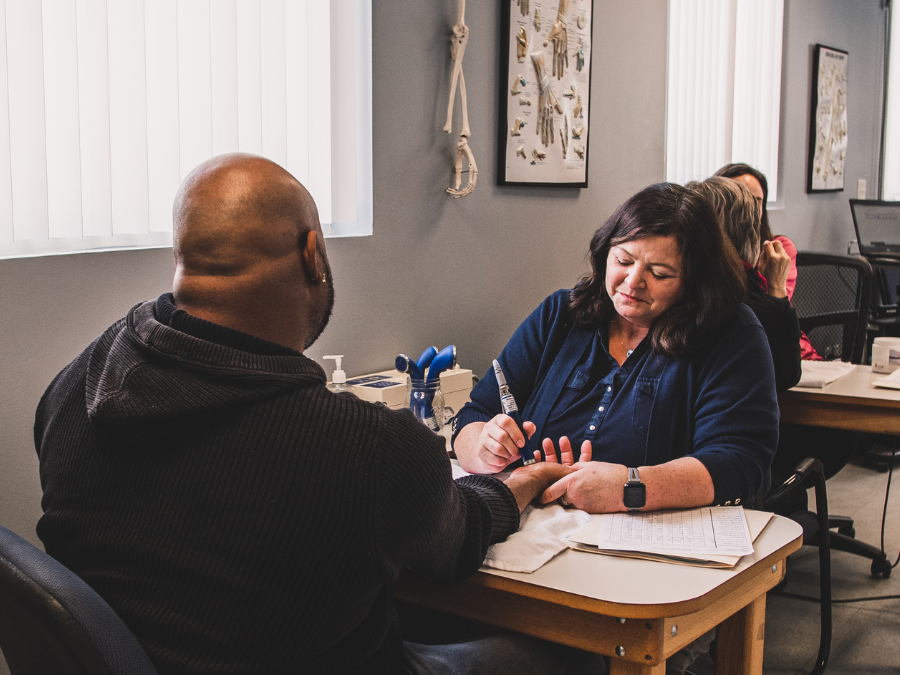Contents
If you’ve experienced pain in your wrist on the same side as your pinky, there’s a name for it: ulnar-sided wrist pain. In general, around 7% of wrist pain is related to the ulna, which is one of the bones in your forearm. This bone helps you move your arm, wrist and hand, and if it gets injured, you may feel pain in your wrist.
Not only does the ulna assist with arm and hand movement, it also holds more than a dozen muscles in place and stabilizes the rest of your arm, wrist and hand. If you’re dealing with ulnar-sided wrist pain, it’s important to address the source of that discomfort. So, let’s take a look at the causes of ulnar-sided wrist pain, the symptoms you may experience, and how physical therapy may be able to help.
What causes ulnar-sided wrist pain?
Ulnar-sided wrist pain can have many causes, from injuries to diseases. Depending on the source of your pain, you may need to treat the condition differently. Here’s a list of some common causes of wrist pain on the pinky side:
- Arthritis — Osteoarthritis and rheumatoid arthritis can both cause pain in your wrists. With osteoarthritis, the protective cartilage can break down with wear and tear, causing inflammation and pain in the wrist. Rheumatoid arthritis occurs when the immune system is dysfunctional and attacks the joints. Pain and stiffness in your joints are both common symptoms of arthritis.
- Ulnar impaction syndrome — A developmental difference in the length of the ulna and the length of the adjacent radius in the forearm can cause ulnar impaction syndrome. The difference in length between these bones causes extra pressure in the wrist area, which can increase wear and tear on the cartilage and ligaments.
- Triangular fibrocartilage complex (TFCC) injury — A TFCC injury occurs when there is a tear or fraying in the tissue that connects the ulna to the other bones and muscles in the wrist. This can result from a fall onto your wrist or through repetitive twisting injuries in the wrist area.
- Nerve injuries or compression — The ulnar nerve sends electrical signals to various muscles in the hand and forearm. When those signals get disrupted, it can cause wrist pain. Injury or intense pressure on the nerves in your wrist, or even higher up in your arm or neck area, can irritate the ulnar nerve into sending pain signals to your wrist.
- Overuse — Repetitive hand and arm movements due to sports, manual labor, or even typing on a keyboard can increase the wear and tear on the tendons and ligaments in the wrist. This extra strain can cause long-lasting damage to that soft tissue and can increase the likelihood of you injuring your wrist.
- Wrist fracture — If your ulna or another bone in your wrist fractures or breaks, it can cause significant wrist pain on the pinky side. You may notice pain, bruising and swelling in the wrist area. Seek treatment from your doctor immediately if you think you have a fractured or broken bone in your wrist.
- Growths — Masses in the wrist such as ganglion cysts, which are benign tumors, can cause irritation and pain in the wrist if left untreated. When these masses grow, they can press down on nerves, ligaments, tendons and joints and make it more difficult for you to move your wrist without pain.
Many different injuries or issues can cause wrist pain on the pinky side. Your doctor or physical therapist may need to examine your wrist to properly assess what’s causing you pain.
What are the symptoms of ulnar-sided wrist pain?
Wrist pain on the pinky side can present with many different symptoms. Sometimes, these symptoms differ depending on the root cause of your pain. Let’s take a look at some of the most common symptoms of ulnar-sided wrist pain:
- Pain on the pinky-finger side of the wrist.
- Wrist pain with movement.
- A popping or clicking noise in the wrist associated with sharp pain while moving.
- Decreased grip strength, often associated with pain.
- Ulnar deviation, a decreased or limited motion of the wrist, especially with rotation of the forearm and with lateral movement of the wrist toward the pinky side.
- Clicking or popping in the wrist, especially with rotation.
These symptoms aren’t exclusive to ulnar-sided wrist pain and may be indicators of other conditions. Talk with your doctor or physical therapist about your symptoms.
In order for your doctor to determine what’s causing your pain, they may do certain tests or examinations. Here are a few things your physician may do to determine what injury you’re dealing with:
- Examine — Your doctor will examine your wrist for any swelling, redness or other external indicators of an injury. They may also gently move your wrist to see what movements cause you pain and where the pain occurs.
- Review — Your doctor will review your medical history with you to determine whether a prior injury or underlying illness may be contributing to your current wrist pain on the pinky side.
- Test — Your doctor may order further testing, such as an X-ray or other imaging tests, to view any internal damage that may be hidden. These tests can show internal fractures, arthritis, abnormal growths and soft tissue injuries.
Before you begin treatment for your ulnar-sided wrist pain, you need to know what’s causing your discomfort. Once your doctor determines the cause of your wrist pain on the pinky side, they may refer you to a physical therapist or suggest other treatment plans.
How can physical therapy address ulnar-sided wrist pain?
There are many ways that physical therapy can reduce and get rid of pain in the wrist on the pinky side. Manual therapy is a form of physical therapy where the physical therapist uses their hands to guide you through gentle, repetitive movements. The goal is to stretch and mobilize the affected joints to increase range of motion while decreasing pain. Here are a few common PT techniques that your therapist may use to address your wrist pain:
- Trigger point therapy — Trigger points are areas in the body that can send pain signals to other areas. With ulnar-sided wrist pain, these trigger points can be muscle knots in the wrist, arm or even neck area. The trigger point therapy technique uses massage to relieve pain in the trigger point as well as the referred pain point.
- Soft tissue manipulation — Soft tissue manipulation is a manual therapy technique that can increase blood flow and stimulate healing in the tissue surrounding the affected joint. This gentle method can relieve tension in the tissue surrounding the wrist, which in turn may reduce pain and pressure
- Joint mobilization — Joint mobilization targets the affected joint with slow, repetitive movements to stretch and mobilize the affected area. The goal of this technique is to gently improve range of motion and reduce stiffness and pain within the wrist on the pinky side.
- Therapeutic exercises and stretches — This type of physical therapist-assisted stretching helps to deepen a stretch in the muscles and isolate the tight tissue in and around the wrist. Stretching can help to improve range of motion, decrease pinched nerve pain, and relieve other pain and stiffness in the wrist area.
- Custom splint fabrication — Custom splint fabrication is a technique where our Lattimore PT specialists create custom splints for different areas of the body. These can help stabilize a damaged joint and support the surrounding muscles during the healing process. If you’re dealing with a wrist strain or sprain in the ulnar area, a splint may help reduce pain and inflammation.
Your physical therapist will design a custom treatment plan based on your condition, limitations and needs to help you start on a path toward healing. Don’t let your wrist pain limit your daily activities. Contact our Lattimore Physical Therapy team today for more information or to schedule an initial appointment to see how our physical therapists can help you get your wrist mobility back.



